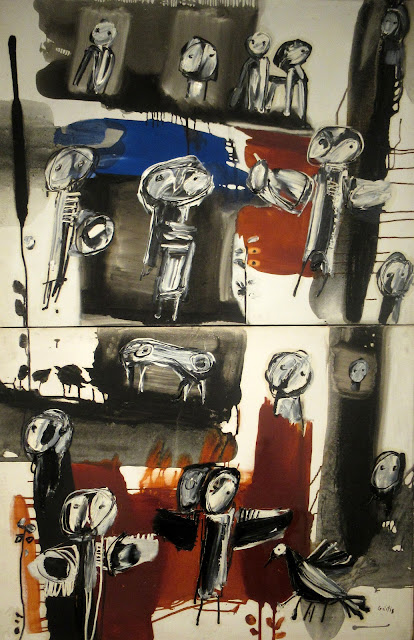Yannis Gaitis - The Essence of Anonymity
Born in 1923, Gaitis studied at the Athens School of Fine Arts and in 1949 he participated with Alekos Kontopoulos and other artists who had turned to abstract art in the founding of the group The Extremists, a group which was opposed to academic art. In 1954 he went to Paris where he completed his studies. He started by painting portraits and then moved on to work that was influenced by Surrealism and Picasso. He quickly moved on to abstract expressionism and surrealist compositions, then cubist and geometric paintings and sculptures. During this stage of his work we detect the first traces of pop art's influence.
From the middle Sixties he began to make his Little People': blank-faced, uniform, anonymous, homogeneous, interchangeable. As the colonels in Greece staged their coup and set up a dictaroship, the expressionistic human profile with the hat appears in his paintings, the motif he is going to simplify and geometricalise turning it into a trade-mark of his work. This alienation in modern society was the main focus of his artistic career, the dominant and distinctive feature in his work. His style is established as pop-art. The formalistic repetition marks the painting of Gaitis from then on and up to his death. At the same petiod he paints the 'Assassination of Freedom', in which a group of soldiers shoot a pigeon.
The first part of the exhibition consists of portraits of his family and his wife, the sculptor Gabriella Simossi, with whom he worked in Paris. Simossi's artworks were also on view and will be the subject of a future post.
The second part of the exhibition consists of works that are influenced by abstract expressionism, surrealism, cubist and other geometric compositions. The last two paintings in this section (and the end of this post) show the direction his work was taking, namely repeating men dressed in hats and plaid jackets, the men who represent our society and its alienation.
The third part, is the part that consists of the work he is most famous for, and will be the subject of the next post.
My Brother Tryphonas, 1945, (oil on cardboard)
Hydra, (Portrait of Gabriella Simossi), 1952, (oil on canvas)
Portrait of Gabriella Simossi, 1950, (oil on canvas)
Portrait of Gabriella Simossi, 1947, (oil on canvas)































Very interesting, I quite liked the 'Portrait of Gabriella Simossi,' and the Aphoridite one beneath. Very clever and skilful.
ReplyDeleteI also liked the affectionate photo (is that his wife?).
I like those too, as well as the two Hydra ones. I had not seen any of his early work before, but have been very familiar with the later work. It was a good exhibition.
ReplyDelete